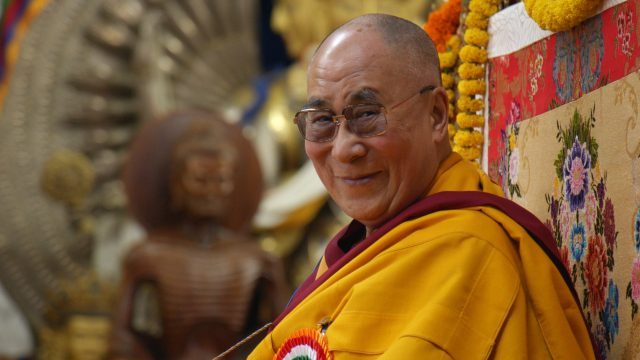
Documentary celebrates the eightieth birthday of the Dalai Lama while looking at the future of the lineage
THE LAST DALAI LAMA? (Mickey Lemle, 2016)
IFC Center
323 Sixth Ave. at West Third St.
Opens Friday, July 28
212-924-7771
www.ifccenter.com
www.thelastdalailamafilm.com
 “So long space remains, so long sentient beings remain, so long suffering remains, I will remain. In order to serve. That is the real purpose of our life,” His Holiness the 14th Dalai Lama says at the beginning of Mickey Lemle’s documentary, The Last Dalai Lama. For nearly 450 years, the spiritual leader of Tibet has been known as the Dalai Lama, reincarnated to continue the lineage and guide the Tibetan people through his wisdom and compassion. But China, in its ongoing suppression of Tibet, has now decided it will choose the next Dalai Lama, so His Holiness, born Tenzin Gyatso in 1935, has vowed that if necessary, he will reincarnate as someone other than a Dalai Lama, bringing an end to the chain. Lemle introduced the world to the 14th Dalai Lama in 1993 with the release of Compassion in Exile: The Story of the 14th Dalai Lama; the new film, which Lemle wrote, produced, directed, and coedited, was made in conjunction with His Holiness’s eightieth birthday, which was celebrated with a Long Life Ceremony at the Javits Center in New York City (that we attended). The film reveals the Dalai Lama, a Buddhist meditation practitioner who escaped Tibet in 1959 and set up a new home in Dharamsala, India, to be both a mensch and a superstar, a man of deep, philosophical wisdom and great compassion for all sentient beings, as well as a very funny man with an infectious laugh. Lemle (The Other Side of the Moon, Ram Dass Fierce Grace) investigates the history of Tibetan relations with China while exploring the biography of the Dalai Lama, including interviews he made with him in the early 1990s.
“So long space remains, so long sentient beings remain, so long suffering remains, I will remain. In order to serve. That is the real purpose of our life,” His Holiness the 14th Dalai Lama says at the beginning of Mickey Lemle’s documentary, The Last Dalai Lama. For nearly 450 years, the spiritual leader of Tibet has been known as the Dalai Lama, reincarnated to continue the lineage and guide the Tibetan people through his wisdom and compassion. But China, in its ongoing suppression of Tibet, has now decided it will choose the next Dalai Lama, so His Holiness, born Tenzin Gyatso in 1935, has vowed that if necessary, he will reincarnate as someone other than a Dalai Lama, bringing an end to the chain. Lemle introduced the world to the 14th Dalai Lama in 1993 with the release of Compassion in Exile: The Story of the 14th Dalai Lama; the new film, which Lemle wrote, produced, directed, and coedited, was made in conjunction with His Holiness’s eightieth birthday, which was celebrated with a Long Life Ceremony at the Javits Center in New York City (that we attended). The film reveals the Dalai Lama, a Buddhist meditation practitioner who escaped Tibet in 1959 and set up a new home in Dharamsala, India, to be both a mensch and a superstar, a man of deep, philosophical wisdom and great compassion for all sentient beings, as well as a very funny man with an infectious laugh. Lemle (The Other Side of the Moon, Ram Dass Fierce Grace) investigates the history of Tibetan relations with China while exploring the biography of the Dalai Lama, including interviews he made with him in the early 1990s.
Lemle speaks with Richen Khando Choegyal of the Tibetan Nuns Project about the self-immolation of young monks as a protest to Chinese policies, visits two classrooms in New York, and meets with HH’s younger brother, Tendzin Choegyal; HH’s personal physician, Tenzin Choedrak; chant master and longtime political prisoner Thupten Chokdhen; Dr. Daniel Goleman, author of A Force for Good: The Dalai Lama’s Vision for Our World; the Very Reverend James Parks Morton and the Very Reverend James A. Kowalski of the Cathedral Church of St. John the Divine, where Philip Glass, who composed the film’s score with Tenzin Choegyal, plays the pipe organ; Ling Rinpoche, the reincarnation of the Dalai Lama’s childhood teacher; Buddhist monk Dr. Mathieu Ricard, author of The Monk and the Philosopher: Buddhism Today; and HH’s translator, Dr. Thupten Jinpa. George W. Bush, who was the first U.S. president to make a public appearance with the Dalai Lama, awarding him the Congressional Gold Medal in 2007, shows off his portrait of HH. There’s also an intriguing section, with colorful animation, about the Dalai Lama’s interest in cutting-edge brain science, as he’s funding a project in which Dr. Eve Ekman and her father are creating an “atlas of emotions,” mapping enjoyment, ecstasy, fear, sadness, anguish, disgust, anxiety, and many others. Despite the problems with China, which are only getting worse, the Dalai Lama even has compassion for his enemies. He also discusses how this is not just about Buddhism. “We are working for seven billion human beings,” he tells Dr. Ekman. “That’s my view.” Meanwhile, the Very Reverend Kowalski asks, “Can human beings be this special?” According to His Holiness, every one of us has the potential to reach selfless levels of compassion, empathy, and peace of mind. The film can be scattershot and bumpy, jumping around too much, but the message is clear: Together we can change the world, but we must change ourselves first. The Last Dalai Lama? opens July 28 at IFC, with Lemle participating in Q&As following the 7:25 screenings on Friday and Saturday.